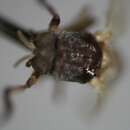en
names in breadcrumbs


Since 1973, the World Health Organization (WHO) has led the Onchocerciasis Control Program (OCP) in West Africa. The programs goal is to control the population of Simulium damnosum through the use of insecticide in the savanna regions of West Africa where the Onchcercisis volvulus filarial worm causes the most social and economic damage.
US Federal List: no special status
CITES: no special status
Simulium damnosum eggs hatch within a few days and larvae attach to objects in the water using their abdominal proleg. The larval stage has seven instars, which can take between seven to fourteen days to complete. Following the larval stage is a pupal stage that takes two to six days to complete, after which the S. damnosum fly emerges to the surface in a protective bubble of air and lives for about three or four weeks as an adult out of water.
Development - Life Cycle: metamorphosis
Simulium damnosum is the primary vector for the Onchcerca volvulus filarial worm, or river blindness parasite that affects humans in Africa. Transmission to humans occurs during feeding of S. damnosum, when the filarial worm travels from the proboscis of the fly into the bleeding wound. River blindness is not fatal, but does cause disfigurement and blindness; approximately 18 million people are infected globally, about 99% of which are in Africa.
Negative Impacts: injures humans (bites or stings, carries human disease)
There is no known economic benefit derived from this species.
Larval S.damnosum show little selectivity, feeding on dissolved organic matter, bacteria, diatoms, algae, and animal matter. Both male and female adult S. damnosum feed on nectar, in particular Rhus natalensis bushes, but only the female feeds on blood. Blood feeding by the female occurs using her serrated mandibles, creating a "mini-wound" where blood begins to ooze out. Feeding often occurs in the morning, in the evening, and on cloudy days when there is decreased light intensity and high humidity.
Animal Foods: blood; zooplankton
Plant Foods: nectar; algae
Other Foods: detritus ; microbes
Primary Diet: carnivore (Sanguivore ); herbivore (Nectarivore )
Simulium damnosum is widespread in throughout western, eastern, central, and southern Africa.
Biogeographic Regions: ethiopian (Native )
Egg and larval development take place in fast-flowing white-water rivers in tropical and temperate regions of Africa. Adult S. damnosum flies inhabit both forests and savannahs in the tropical and temperate regions.
Habitat Regions: tropical ; freshwater
Terrestrial Biomes: savanna or grassland
Aquatic Biomes: rivers and streams
Other Habitat Features: riparian
Deposited eggs from of the species Simulium damnosum are about 0.20 mm in length; mature larvae can reach a length of 5.5 to 9.5 mm and are worm-like. Larvae have three distinct features: A pair of cephalic fans on the head used for feeding, two psudopods know as prolegs or "false feet" which consists of a series of 30 to 50 rows of hooks, and a thoracic proleg located on the underside immediately behind the head and is used in locomotion. The abdominal proleg at the hind end of the body is used to secure the larvae to a substrate when it is stationary. Adult S. damnosum can reach a length of 3 to 4 mm. The body is composed of a head, a thorax that is humped in relation to the rest of the body, and an abdomen. Both sexes have a conspicuous white band on each of the hind tarsi. Males tend to be black, while females tend to be grayer. In addition, males have a reflective silvery mark on their abdomen that aids in recognition by females during mating. The mandibles in females are larger and have a row or teeth that are used for cutting and bloodletting.
Range length: 3 to 4 mm.
Other Physical Features: ectothermic ; heterothermic ; bilateral symmetry
Sexual Dimorphism: sexes colored or patterned differently; sexes shaped differently
Copulation is believed to only occur once in females.
Mating System: polygynous
After copulation sperm are usually stored in the spermatheca where it is used later for fertilization once the eggs have become mature. After the eggs are fertilized they are oviposited in large masses consisting of about 700 eggs, in some cases deposits of 1100 eggs have been observed. The eggs are deposited in fast flowing water just below the surface on vegetation or other protruding objects.
Range eggs per season: 700 to 1100.
Key Reproductive Features: semelparous ; sexual ; fertilization (Internal ); oviparous ; sperm-storing